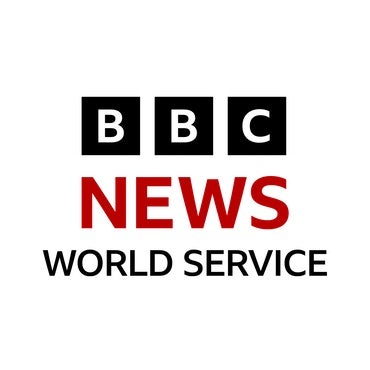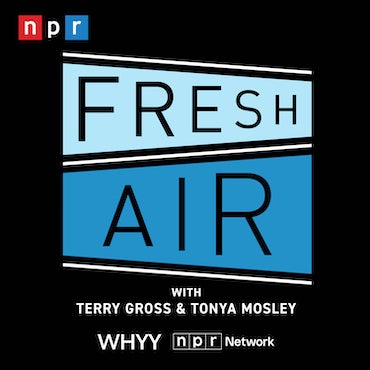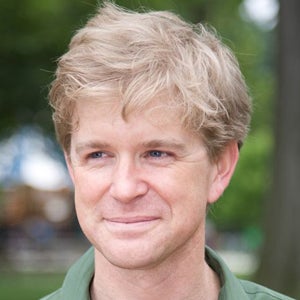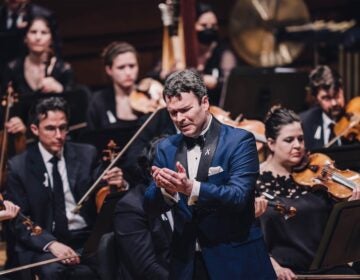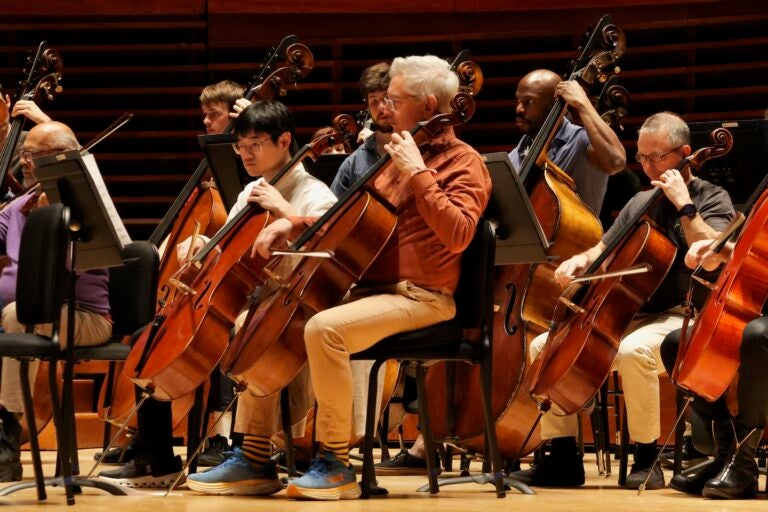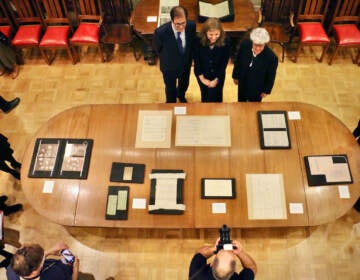‘Picaflor: A Future Myth’: Philadelphia Orchestra premieres work about climate apocalypse averted by a hummingbird
Gabriela Lena Frank’s “Picaflor: A Future Myth” digs into ancient Peruvian mythology to tell a story about the future.
Listen 2:41
Conductor Marin Alsop leads the Philadelphia Orchestra through a rehearsal of ''Picaflor: A Future Myth'' by Gabriela Lena Frank at the Kimmel Center. (Emma Lee/WHYY)
From Philly and the Pa. suburbs to South Jersey and Delaware, what would you like WHYY News to cover? Let us know!
This weekend, the Philadelphia Orchestra premieres a piece by composer Gabriela Lena Frank. “Picaflor: A Future Myth” is based on the mythology of the Incan people from the Andes region of South America and tells a story about the hummingbird, a mythical figure associated with warrior-like resilience.
Frank wrote the piece in response to what she sees as a dire global environmental crisis. Increasingly hotter climate conditions have caused rising oceans and destructive weather patterns globally, particularly in California, which is prone to wildfires.
“It’s inescapable for me now,” said Frank, who lives in Northern California, not far from the 2018 Camp Fire, the largest fire in California history that destroyed several rural towns.
“Every day I breathe, and I think about my safety,” she said. “I think about the planet that we’re leaving to our children.”
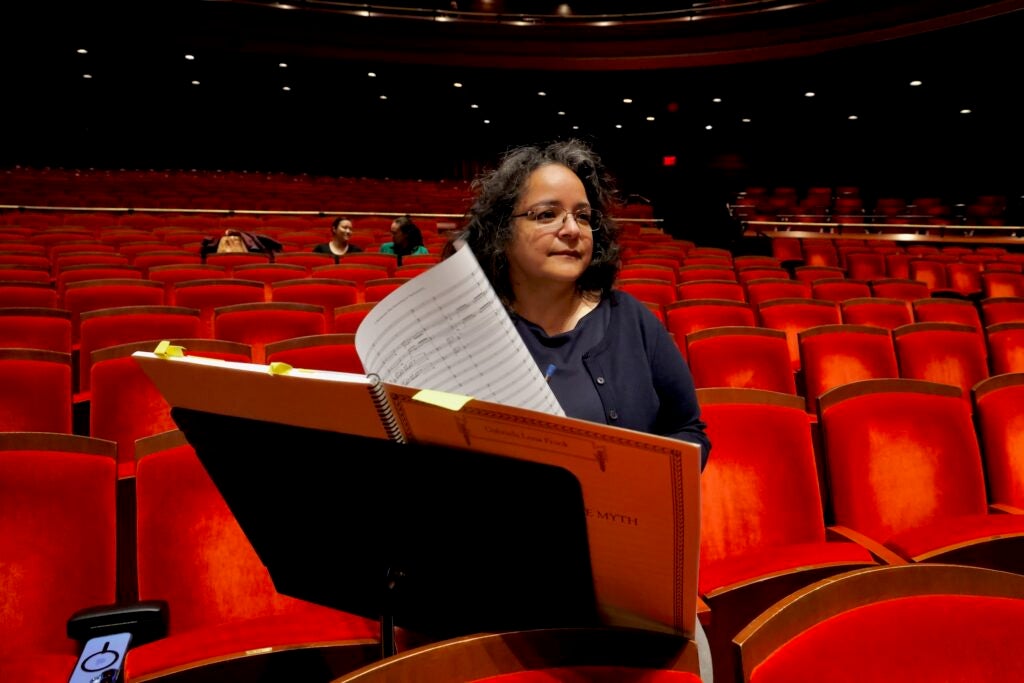
More than a decade ago, Frank conceived a piece based on figures of Incan origin myths, in particular the hummingbird which passes through a membrane separating the immortal sun kingdom in the sky from the earthly realm below, by pecking a hole in it.
“My mom is a Peruvian-born woman, and picaflor means picking at flowers,” she said. “That’s what a hummingbird does: They pick at flowers.”
Like a winged Prometheus, the picaflor flies through its hole with a bit of fire in its beak stolen from the sun.
But while that story of the picaflor was flitting inside Frank’s head, the world around her changed: a pandemic, devastating wildfires, widespread flooding and climate change.
“The environmental crisis has been really dire,” she said. “We’ve seen great political change and I could no longer in good conscience tell this same story.”
So rather than an ancient origin story, Frank’s picaflor is set in the future, describing how the tiny hummingbird might save the earth from desolation. The composition is informed by the Incan concept of Pachacuti, or how transitions occur through periods of tremendous cataclysm.
The 10 non-narrated movements of “Picaflor” are chapters in a story of a fight for the future of the world.
It starts with the flooding of Pachamama, aka Mother Earth in Andean mythology, and widespread extinction.
“The first movement starts off with a line that says, in the program note: ‘Extinction is what human beings called it,’” Frank said. “The sun god called it safekeeping, as he was taking back his animals. That’s where hee was keeping them safe.”
The picaflor arrives in the second movement, flying down from the sun kingdom. Frank wanted to keep her instrumentation consistent with the classical western orchestra, so she did not use a traditional Peruvian pan pipe to represent the call of the Peruvian bird.
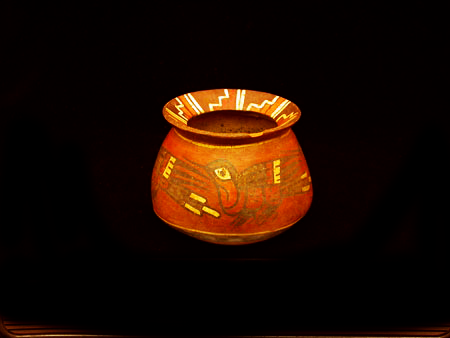
Instead, Frank wrote for flutes in a way that mimics the sound of the wooden pan pipe.
“If I could marry a Peruvian pan pipe with a western classical flute and they have a baby, what kind of music would it make?” she said.
Technically, “Picaflor” challenges musicians. Frank said the score has a lot of sudden changes, is written attacca without rests between movements, and has “a lot of black on the page, as we composers say where there’s just a lot of things to do.”
Frank wrote most of the scores while she was composer in residence with the Philadelphia Orchestra. She was inspired by the orchestra’s virtuosity.
“I told them at the top of the rehearsal, ‘I wrote this for you. I know you. I know how you play,’” she said. “I’m showing off every person in this orchestra. Every section of the orchestra participates in the story of the picaflor.”
“Picaflor” has a large cast of characters including a sun god, an ancient mollusk, a speedy Chaski messenger, a love story, a battle scene, and at one point petroglyph stone carvings peel themselves off the surface of the rock and start dancing.
There’s no narrator to explain what’s happening. It’s all told solely through music and detailed in the program notes. Frank said audience members can follow along by reading the notes, or just listening and imagining.
“Everybody owns their listening and experience with it,” she said. “At some point you may be, like, ‘I bet that’s the picaflor theme.’ ‘No, wait, that could be the picaflor theme.’ Then something comes up that’s very muscular, like, ‘OK, that’s the fight scene. That’s obviously not the love song.’”
The Philadelphia Orchestra will premiere “Picaflor: A Future Myth” this weekend on a program with Mendelssohn’s “Violin Concerto” and Brahms’ “Variations on a Theme of Haydn.” The orchestra plans to perform it again this summer while in residence in Vail, Colorado.

Saturdays just got more interesting.
WHYY is your source for fact-based, in-depth journalism and information. As a nonprofit organization, we rely on financial support from readers like you. Please give today.
